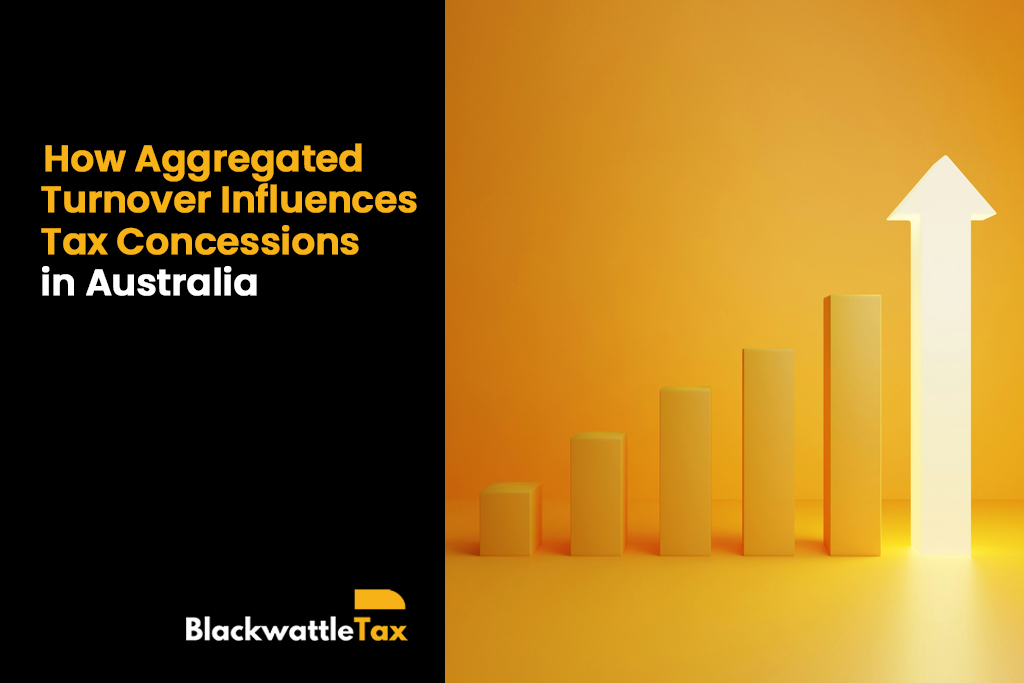As a business owner in Australia, you’re constantly exploring avenues for growth and collaboration with other businesses. In this pursuit, the significance of comprehending tax concessions becomes increasingly evident.
One crucial metric that shapes eligibility for these concessions is aggregated turnover, as determined by the Australian Taxation Office (ATO). This metric encompasses not only the annual revenue of the business itself but also that of its connected entities and affiliates.
In this blog, we aim to provide a foundational understanding of aggregated turnover and its impact on the availability of tax benefits for businesses in Australia.
What is an aggregated turnover?
Aggregated turnover is a key metric used by the Australian Taxation Office (ATO) to determine the size and eligibility of a business for various tax concessions. It includes the total annual turnover of the business entity itself plus all of its connected entities and affiliates.
What is the meaning of connected entities?
Understanding connected entities is key when calculating your aggregated turnover. This involves identifying any connections with other entities, such as affiliates, and determining if there are control relationships between them.
The question of ‘control’ is central to determining who is connected with a business. These connected or affiliated entities may be based in Australia or overseas.
- Connected entities: are those linked by ownership or control
- Affiliates: include entities connected by a business partnership, trust, or similar arrangements.
Calculating aggregated turnover involves combining the annual turnovers of the primary business and its related entities, providing a comprehensive view of the economic activity associated with the business structure.
Tax concessions based on aggregated turnover
Aggregated turnover serves as a crucial criterion for businesses to access different tax concessions in Australia. Several concessions are tailored to the specific needs of small to medium enterprises (SMEs), and the eligibility thresholds are often tied to aggregated turnover.
Tax Concessions | Aggregated turnover must be less than |
Small business CGT concessions including CGT 15-year asset exemption, CGT 50% active asset reduction, CGT retirement exemption and CGT replacement asset rollover | $2 million |
Small Business Income Tax Offset is available for unincorporated small businesses. This offset provides a discount on the income tax payable on business income. | $5 million |
Small business restructure rollover, simpler BAS, accounting for GST on a cash basis, annual apportionment of GST input tax credits, and paying GST by instalments | $10 million |
Small business entity concessions, simplified depreciation rules, and rollover relief. This covers a range of concessions, including simplified depreciation rules, immediate deductibility for certain start-up expenses, and the option for simplified trading stock rules. | $10 million |
FBT car parking exemption and work-related devices exemption | $50 million |
Variety of small business concessions such as deductions for professional expenses for start-ups, immediate deductions for prepaid expenses, simplified trading stock rules, PAYG instalments concession, a two-year amendment period and the excise concession | $50 million |
Need help calculating your aggregated turnover? Connect with our team at Blackwattle Tax.
At Blackwattle Tax, we’re your trusted outsourced accounting team. We understand the challenges of calculating your aggregated turnover. Our team of seasoned professionals, including chartered accountants and registered tax agents, is here to simplify the process for you.
We prioritise keeping our clients from diverse sectors informed about their aggregated turnover and support them in exploring various concessions to optimise their tax situation.
Schedule a FREE 30-minute consultation today to discover how we help clients make strategic decisions to reach their financial goals while adhering to Australian tax regulations.
Stay informed and empowered by subscribing to our monthly newsletter, delivering valuable insights on business advice, investment tips, and strategic tax planning.
Disclaimer: We endeavour to make sure the information provided in this guidance is up to date and accurate. Please note, that the information is only intended to be a guide, with a general overview of information. This guidance is not a comprehensive document and should not be interpreted as legal advice or tax advice. The information is general in nature. You should seek the assistance of a professional opinion for any legal and tax issues related to your personal circumstances.













